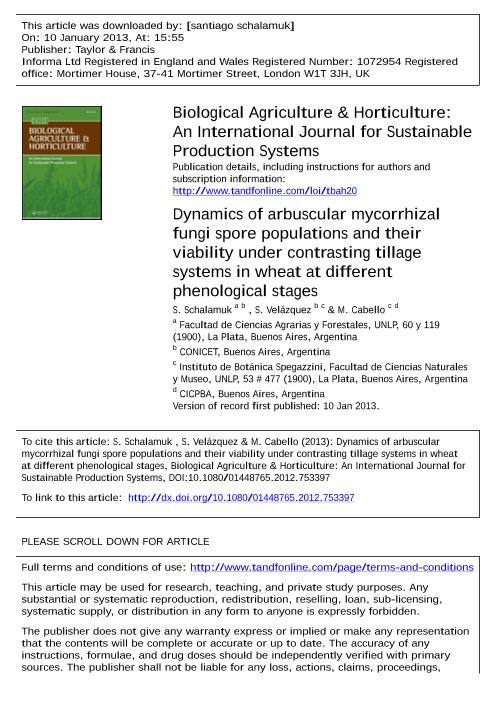Artículo
Dynamics of arbuscular mycorrhizal fungi spore populations and their viability under contrasting tillage systems in wheat at different phenological stages
Fecha de publicación:
01/2013
Editorial:
A B Academic Publisher
Revista:
Biological Agriculture & Horticulture
ISSN:
0144-8765
Idioma:
Inglés
Tipo de recurso:
Artículo publicado
Clasificación temática:
Resumen
Arbuscular mycorrhizal fungi (AMF) are influenced by soil management. The use of different tillage systems affects AMF activity. AMF spores are formed in soils or roots and provide a long-term reservoir of inoculum in the field. As spores can persist in soils, they reflect the accumulated sporulation history of the respective soil and not necessarily the current symbiosis of the crop. The aim of this study was to evaluate the AMF spore population dynamics and spore viability in conventional tilled and non-tilled soils throughout the wheat growing cycle and its fallow in the warm temperate Argentine Pampas. It was found that the differences in spore abundance between both tillage systems depend on the phenological stage of the crop. In both years, at the early phenological stages of the wheat crop, spore counts were about two or three times higher in no-tillage (NT) than in conventional tillage (CT). The lower spore counts in CT at the end of the fallow and at the early crop stages could be explained by the dilution of the AMF propagules in the zone of seedling establishment by ploughing. The percentages of viable spores varied with the treatments and the sampling periods, with values ranging from 10.5% to 58.8%, and were higher in CT in all the phenological stages and significantly higher at tillering stage. Assuming that a viable spore could be newly formed, then the lower percentages of viable spores in NT may suggest a higher accumulation of old residual spores.
Palabras clave:
Conventional Tillage
,
Glomeromycota
,
No-Tillage
,
Number of Spores
,
Vital Stain
Archivos asociados
Licencia
Identificadores
Colecciones
Articulos(CCT - LA PLATA)
Articulos de CTRO.CIENTIFICO TECNOL.CONICET - LA PLATA
Articulos de CTRO.CIENTIFICO TECNOL.CONICET - LA PLATA
Citación
Schalamuk, Santiago; Velázquez, María Silvana; Cabello, Marta Noemí; Dynamics of arbuscular mycorrhizal fungi spore populations and their viability under contrasting tillage systems in wheat at different phenological stages; A B Academic Publisher; Biological Agriculture & Horticulture; 29; 1; 1-2013; 38-45
Compartir
Altmétricas




